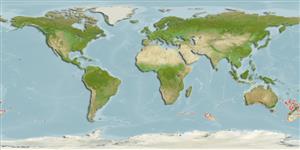>
Perciformes/Scorpaenoidei (Scorpionfishes) >
Sebastidae (Rockfishes, rockcods and thornyheads) > Sebastolobinae
Etymology: Trachyscorpia: Greek, trachys, -eia, y = rough + Greek, skorpis, idos = a kind of fish without identification (Ref. 45335); carnomagula: The specific name carnomagula is derived from the Latin carnosus meaning fleshy, and
magulum meaning jaw or mouth, in reference to the fleshy lip on the upper jaw, compared with the poorly developed lip of T. eschmeyeri. The E.
More on authors: Motomura, Last & Yearsley.
Environment: milieu / climate zone / depth range / distribution range
Ecologia
marino benthopelagico; distribuzione batimetrica 731 - 1020 m (Ref. 58335). Temperate
Distribuzione
Stati | Aree FAO | Ecosystems | Presenze | Point map | Introduzioni | Faunafri
Pacific Ocean: currently known only from the southwestern Pacific Ocean (Tasman Sea and northern New Zealand) at depths of 731-1020 m. One specimen (CSIRO H 2625-02, 263.3 mm SL, non-type), tentatively identified as T. carnomagula in ref. 58335 , was collected from southwest of Western Australia, Indian Ocean, at a depth of 738–750 m. Trachyscorpia carnomagula co-occurs with T. eschmeyeri.
Size / Peso / Age
Maturity: Lm ? range ? - ? cm
Max length : 36.9 cm SL maschio/sesso non determinato; (Ref. 58335)
Short description
Morfologia | Morfometria
Spine dorsali (totale): 13; Vertebre: 26. Tympanic spines present; upper-jaw lip well developed, covering most of premaxillary tooth band laterally; no scales on lateral surface of maxilla; 57–63 scale rows in longitudinal series; second pelvicfin soft ray short (17.9-24.9% SL, mean 20.3%), shorter than upper-jaw length; body deep (depth 34.3-42.5% of SL, mean 38.0%); orbit diameter large (14.1–18.0% of SL, mean 16.1%); pelvic-fin spine short (9.4–15.9% of SL, mean 12.4%); first anal-fin spine short (5.1–7.7% of SL, mean 6.4%); head profile convex; swimbladder
present; head and trunk whitish with two blackish bands from eye on head and 4 blackish saddles on body in preserved specimens (Ref. 58335).
Life cycle and mating behavior
Maturità | Riproduzione | Deposizione | Uova | Fecundity | Larve
Motomura, H., P.R. Last and G.K. Yearsley, 2007. Two new species of the scorpionfish genus Trachyscorpia (Sebastidae: Sebastolobinae) from the southern Indo-West Pacific, with comments on the distribution of T. eschmeyeri. Zootaxa 1466:19-34. (Ref. 58335)
IUCN Red List Status (Ref. 130435)
Threat to humans
Harmless
Human uses
Informazioni ulteriori
Nomi ComuniSinonimiMetabolismoPredatoriEcotossicologiaRiproduzioneMaturitàDeposizioneSpawning aggregationFecundityUovaEgg development
Age/SizeAccrescimentoLength-weightLength-lengthLength-frequenciesMorfometriaMorfologiaLarveDinamica popolazioni larvaliReclutamentoAbbondanzaBRUVS
BibliografiaAcquacolturaProfilo di acquacolturaVarietàGeneticaElectrophoresesEreditarietàMalattieElaborazioneNutrientsMass conversion
CollaboratoriImmaginiStamps, Coins Misc.SuoniCiguateraVelocitàModalità di nuotoArea branchialeOtolithsCervelliVista
Strumenti
Special reports
Download XML
Fonti Internet
Estimates based on models
Preferred temperature (Ref.
123201): 2.1 - 7.5, mean 6.1 °C (based on 72 cells).
Phylogenetic diversity index (Ref.
82804): PD
50 = 0.5156 [Uniqueness, from 0.5 = low to 2.0 = high].
Bayesian length-weight: a=0.00912 (0.00410 - 0.02027), b=3.09 (2.89 - 3.29), in cm total length, based on LWR estimates for this (Sub)family-body shape (Ref.
93245).
Trophic level (Ref.
69278): 3.8 ±0.5 se; based on size and trophs of closest relatives
Resilienza (Ref.
120179): Basso, tempo minimo di raddoppiamento della popolazione 4.5 - 14 anni (Preliminary K or Fecundity.).
Fishing Vulnerability (Ref.
59153): Low to moderate vulnerability (35 of 100).
